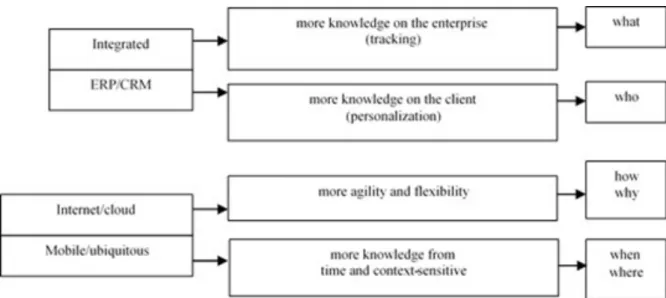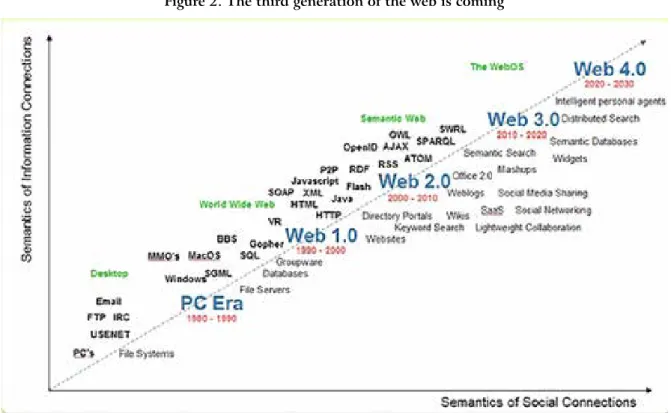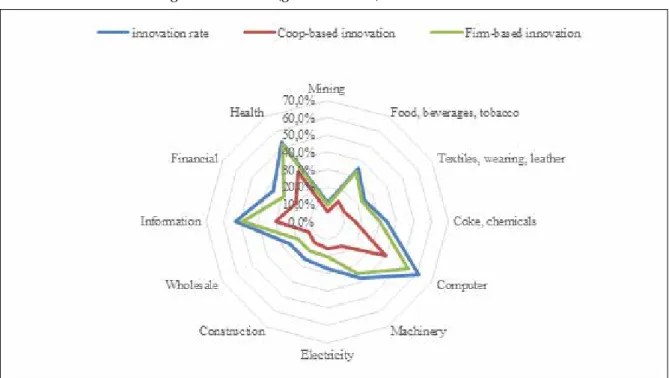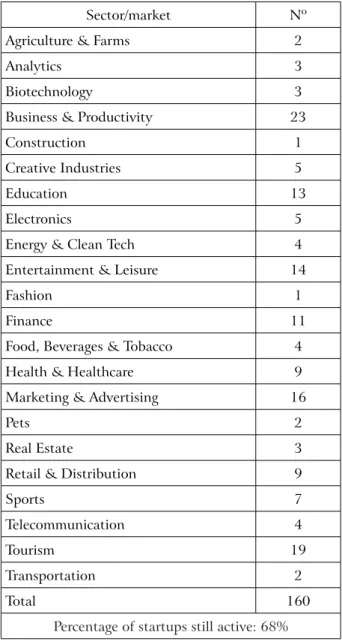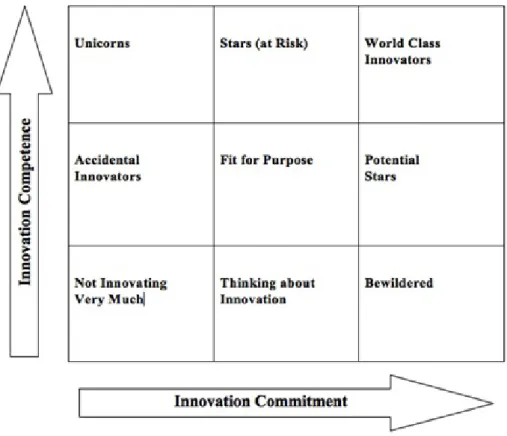INTERDISCIPLINARY ENGINES: THE PORTUGUESE CASE
Silvia Fernandes1 ABSTRACT
Today’s competition is tough, due especially to emergent information systems (IS) and information technology (IT) support. Managers must continuously cope with challenges to keep their businesses innovative and sustainable. They take most of their decisions based on considerable amounts of data. An important step is to employ strategies based on open innovation: partnerships with people who know the technology better, or how to conceive or run a certain activity, product or process. All these issues and potentials have been explored and supported in the so-called innovation accelerators or ‘boot camps’, either for launching new businesses or supporting their IT/IS platforms. These initiatives are based on a dynamic entrepreneurial and interdisciplinary ambience, which introduces the candidates (mainly start-ups, spin-offs) to consultants, investors, managers, designers, innovators, etc. This study determines where Portugal stands in terms of innovation in general, open innovation (cooperative or firm-based), venture capital adherence and innovation sustainability. It then discusses the results of some Portuguese innovation accelerators (such as ‘Beta-i’ and ‘Cria’) from the point of view of target sectors/markets and the sustainability of accelerated firms over time.
Keywords: Innovation Accelerators, Entrepreneurship, Partnerships, Open Innovation. JEL Classification: O31, O32, O33.
1. INTRODUCTION
Today’s competition is tough and global, and this is especially true for information systems (IS) and information technology (IT) offerings. Meeting and mastering this challenge is essential to maintaining a long-term competitive edge. Managers make most of their decisions based on a considerable amount of data to that helps them know what products they should offer, in which quantity, from which supplier, the best means of distribution, the best location for stores and how to organize the transport. An important step in building more dynamic and creative businesses is to employ innovative strategies based on the use of modern information and communication technologies. These have led to new features for sustaining business competitiveness: integrated systems, interactivity, mobile platforms, creative design, etc.
These responses require IT-based tools, increased information content and creative teams. Any enterprise that wants to optimize its success in the information society must have a basic awareness of, and a strategy for, dealing with this new environment. With the shortening of life cycles and time to market, this has to evolve at a pace that approaches the need for its real time creation (Philipson, 2008). For example, the internet brings critical 1 Silvia Fernandes, University of Algarve, Faculty of Economics, Research Centre for Spatial and Organizational Dynamics, Faro, Portugal.
new functionalities for enterprises through real time business dynamics and relations. If they don’t constantly improve the process of managing this, they will quickly become paralyzed. 1.1. The IS/IT ‘battle field’
Building custom software systems can become so complex that the software requires an ‘army’ of engineers and consultants to manage it. Small to medium businesses need a way to organize their data on a smaller scale and without the expense of hiring costly consultants or paying for maintenance contracts. The approach of building and managing a custom software solution is financially out of reach for small- and medium-sized companies, and therefore companies are moving to web-based software, as it can eliminate the need to purchase and manage computer servers, firewalls and software servers just to run the application. A broadband connection to the internet is recommended to sustain a design in a very modular way, which allows for tremendous flexibility in building platforms that meet the needs of a particular activity.
These trends, as well as being key for business performance, can be a means of knowledge-base enhancement (Gudas, 2008; Fernandes, 2013). Figure 1 illustrates this through the main lines of information system support and the resulting enterprise knowledge expansion (the last blocks allow answers to questions like how/why and when/where).
Figure 1. Main lines of information systems’ support and knowledge-base enhancement
Source: own elaboration
One relevant trend is the widespread use of mobile platforms, and their ubiquity (concept of being everywhere at the same time, through combining pervasive devices, i.e. time and context-sensitive). These attributes have to do with the critical role that time and place play in today’s communications. Facing the increasing geographical scope and time-sensitiveness of services (real-time response), their development is making a difference. One result is the controlled execution of activities by creating processes that resolve many problems related to punctual delivery to the requested location. Ubiquitous systems provide mechanisms for the selection and alignment of processes that meet the issues of a context and accurately reflect its constant changes. This pervasive nature, related to the capacity of different integrated
Figure 2 shows another trend in emergent IT, the semantic web (or intelligent web) related to semantic databases whose data can be from different platforms (such as social networks) . These can perform or shape tasks with clients/ users.
Figure 2. The third generation of the web is coming
Source: http://www.novaspivack.com/articles
Shaping users to enterprise goals will put these ahead of client perceptions and aspirations, as enterprises can use social networks for customer research. Firms can create scenarios for interacting with customers as they know more about business, marketing, management and entrepreneurial issues. Social networks are very important when studying and exploring client perspectives. These platforms can capture clients/users in many segments and regions/ countries. They can even build a social network’s CRM (Customer Relationship Management) system. Microsoft’s (2009) white paper has already approached this integration, a powerful tool for online data to increase customer engagement and business creativity.
All these challenges and potentials have been considered and explored by the so-called innovation accelerators or ‘boot camps’, either for launching new businesses (mainly start-up generation) or sstart-upporting their IS/IT platforms.
2. INNOVATION ACCELERATORS: CONCEPT AND POTENTIAL
An innovation accelerator is an intensive business program (usually three months) which includes mentorship, educational components, and networking, and aims to help business grow rapidly. It is an open, entrepreneurial and interdisciplinary environment. Usually the entrepreneur moves into a shared space with other new founders to work under the tutelage of advisors and experts. In exchange for the expert mentoring, exposure to investors and a cash investment from the accelerator, the entrepreneur gives a portion of their company’s equity to the partners of the program, and for this reason it is often called a ‘seed’ or ‘venture’ accelerator. Other elements are:
• The accelerator program consists of five elements (Christiansen, 2009): 1) funding, typically to the seed level; 2) company founders, small teams with technical backgrounds; 3) each group supported for a defined period of time; 4) an education program, focusing on business advice and/or product advice; and 5) a networking program, to meet other investors and advisors. Accelerator programs may include office space (whether free or subsidized) and a demonstration day for funded companies;
• An accelerator program model comprises five main features which set it apart from other approaches to investment or business incubation (Miller & Bound, 2011): 1) an application process, open to all yet highly competitive; 2) provision of pre-seed investment, usually in exchange for equity; 3) a focus on small teams, not individual founders; 4) time-limited support, comprising programmed events and intensive mentoring; and 5) groups or ‘classes’ of start-ups rather than individual companies; • Seed accelerators are fixed-term, cohort-based programs that include mentorship and
educational components and culminate in a public pitch event or demonstration day. While traditional business incubators are often government-funded and focus on biotech, medical technology, clean tech or product-centric companies. Accelerators can be either privately or publicly funded and focus on a wide range of industries. 3. INNOVATION ACCELERATORS IN PORTUGAL
3.1. The innovation scene in Portugal
Recent innovation metrics for countries can be found in an important secondary dataset, the CIS-2012 (DGEEC, 2014). The Community Innovation Survey (CIS) is the main statistical survey (mandatory for EU member states) on innovation in companies. The European Union employs this statistical instrument to monitor Europe’s progress in the area of innovation, as conducted by national statistical offices. In Portugal, following the recommendations of Eurostat, the CIS aims to directly collect information on innovation (product, process, marketing, and organizational) in companies. Data collection, corresponding to the period of 2010-2012, was performed during 2014 through an online electronic platform. It contemplates Portuguese companies with ten or more employees belonging to several NACE codes (economic activities). Among the 7995 companies in the corrected sample, 6840 valid answers were considered, corresponding to a response rate of 86%.
The CIS instrument also provides useful information about how firms are interrelated in its surrounding external environment in order to access information considered important for the development of new innovation projects or the completion of existing ones. Firms may use external agents as information sources or engage in more formal cooperation activities, meaning their active participation with other enterprises or institutions on innovation accomplishments. But which sectors innovate the most? Is it cooperative or firm-based innovation? The following figures will help to analyze factors that explain the level and nature of innovation in Portugal.
In terms of products/services, the most innovative sectors are computer and information, followed by health, machinery and finance (Figure 3).
Figure 3. Product (goods/services) innovation metrics
Source: Own elaboration based on CIS 2012 data
In terms of process innovation, the most innovative sectors are computers and health, followed by construction, electricity and information (Figure 4).
Figure 4. Process innovation metrics
Source: Own elaboration based on CIS 2012 data
The following table (Table 1) shows the percentages obtained for cooperative and firm-based innovation by sector and type of innovation. The chosen sectors were those with the highest global innovation rates (product and process innovations). According to this data, firm-based innovation is higher than cooperation-based innovation for the majority
of sectors in both types, especially in product innovation. Portuguese firms tend to be more open to cooperating with others when there is no new product involved.
Table 1. Cooperation vs. firm-based innovation by sector and type
NACE
code Sector Product Innov -
Coop based Process Innov - Coop based Product Innov - Firm based Process Innov - Firm based 26 Computer manufacturing, electronic and optical products 45.3% 41.5% 62.3% 50.9%
42 Civil engineering 12.0% 40.0% 16.0% 32.0%
47 Retail trade, except motor vehicles and motorcycles 46.7% 46.7% 40.0% 60.0% 65 Insurance, reinsurance and pension funding, except compulsory social security 50.9% 47.3% 58.2% 49.1% 72 Scientific research and development (R&D) 40.0% 30.0% 56.7% 46.7% 86 Human health activities 33.0% 40.4% 51.1% 38.3%
Source: Own elaboration based on CIS 2012 data
External sources and interactions are of great importance to small and medium-sized firms, particularly those belonging to knowledge-intensive sectors (Rothwell, 1992; Smith, 1993; Shapira et al., 1995; Malecki and Tootle, 1996). In the process of developing new products/services it becomes essential to perceive the significance of external agents as a source for successful innovation projects. In present economies, firms cannot rely solely on their own resources, they need to balance internal sources and capabilities with ideas from outside, and interact with a large number of players (Szulanski, 1996; Laursen & Salter, 2006; Lundvall, 2010). This can lead to opportunities for more quick and effective technology to catch up, the main strength of the open innovation model (Chesbrough, 2003a, b).
3.2. Innovation challenges
External knowledge connections are a vital factor in the open innovation model (Cohen & Levinthal, 1990; Veugelers, 1997; Chesbrough et al., 2006). Firms that are internally centered need to open their boundaries to external partners, otherwise numerous opportunities are missed (Chesbrough, 2003a; Laursen & Salter, 2006). Several studies support the idea that a firm’s boundary requires porosity in order to absorb knowledge and abilities from the environment (Shan et al., 1994; Leonard-Barton, 1995; Powell et al., 1996; Chesbrough, 2003b). This can provide an extensive variety of novel ideas and innovation opportunities (Powell et al., 1996; Laursen & Salter, 2006) and access to complementary resources that turn an innovation into a market success (Cohen & Levinthal, 1990).
Figure 5 compares Portugal to other European countries, and shows that Portugal has a low level of cooperation-based innovation. In 2012, the countries with the highest levels were the United Kingdom and Belgium, followed by Austria and Denmark. The indicator decreases from 2008 to 2012 in the majority of countries, including those with the highest values.
Figure 5. Percentage of cooperation-based innovation firms2
Source: Own elaboration based on Eurostat data
In terms of exports of high tech products, this percentage has increased in general, however, Portugal and Greece still have the lowest levels (Figure 6).
Figure 6. Percentage of exports of high tech products
Source: Own elaboration based on Eurostat data
Another relevant indicator is venture capital investment, and Portugal also has a low level (Figure 7).
Figure 7. Venture capital investment
Source: Own elaboration based on Eurostat data
These three indicators - cooperation-based innovation, exports of innovative products and venture capital investment - which can be related to open-innovation propensity, suggest that Portugal still has a long way to go. The Global Entrepreneurship Monitor (GEM) suggests that about 8 in 100 people are entrepreneurs in Portugal (involved in startups) and that 1 in 2 entrepreneurs do it out of necessity. Reasons include: the low incomes characterizing this country, missing early collective entrepreneurial culture (path-dependent), difficulties obtaining finance and poor adherence to risk (Sarkar, 2014). These issues may be related to the ‘maturity level’ of innovation acceleration in Portugal and the sustainability of the resulting innovation.
3.3. Innovation acceleration potential
A question emerging from previous assessment is how the open-innovation challenge should be addressed and overcome. Innovation accelerator environments can be real open innovation engines, due to their entrepreneurial and interdisciplinary ambience.
One of the best startup accelerators in the world is Techstars in Boston, USA (http://www. techstars.com/). Fewer than 1% of the companies that apply to it are accepted. One of the few Portuguese startups accepted was DoDOC. This company, established in February 2014 by three students on the MIT doctoral program, was chosen from among 1500 candidates around the world. DoDOC is focused on enterprise solutions for document management, enabling the automation of steps where text outputs require the management of several documents obeying strict rules. The company focuses its market on pharmaceutic and biotech firms, hospitals and universities as these organizations generate high volumes of
de startups’ and ‘Beta-i’ (Figures 8, 9). Other recent Portuguese innovation accelerators are ‘ASA’ (Anje Startup Accelerator); ‘Startup Pirates’; ‘Startup Braga’; and ‘CRIA startups’.
Figure 8. ‘Fábrica de startups’
Source: http://www.fabricadestartups.com/landing
Figure 9. ‘Beta-i’
The statistics about the activity of these accelerators raise another issue, which is about the sustainability of the accelerated firms in time. Table 2 shows the case of Beta-i in terms of the number of accelerated startups (period from 2013 to 2015) and the percentage of those still active.
Table 2. Beta-i accelerator results by sector/market
Sector/market Nº Agriculture & Farms 2
Analytics 3
Biotechnology 3
Business & Productivity 23
Construction 1
Creative Industries 5
Education 13
Electronics 5
Energy & Clean Tech 4 Entertainment & Leisure 14
Fashion 1
Finance 11
Food, Beverages & Tobacco 4 Health & Healthcare 9 Marketing & Advertising 16
Pets 2
Real Estate 3
Retail & Distribution 9
Sports 7
Telecommunication 4
Tourism 19
Transportation 2
Total 160
Percentage of startups still active: 68%
Source: Data from an interview with Isabel Salgueiro, startup manager at ‘Beta-i’
In Beta-i, the sectors/markets with more accelerated startups (in descending order) are: business and productivity; tourism; marketing and advertising; entertainment and leisure; education, and finance. Another case that provided data is CRIA (CentRe for Innovation in Algarve). Table 3 shows its number of accelerated startups and again the percentage of those still active (period from 2011 to 2013). Here, agro-food, tourism, information technology and environment/energy are the sectors/markets with more accelerated firms. These
Table 3. CRIA accelerator results by sector/market
Sector/market Nº
Agro-food 10
Tourism 8
Information Technology 6 Design and Communication 6
Sea sciences 5
Environment and Energy 5
Biotechnology 4
Health 4
Engineering 3
Other 9
Total 60
Percentage of still active startups: 70%
Source: Data from figures provided by CRIA’s coordinator, Hugo Barros
An issue that emerges from these tables is the sustainability over time of the accelerated firms through their innovations. Both percentages of startups that are still active (68% in Beta-i and 70% in CRIA) are significant. But how do these figures evolve over time? The next section discusses this issue and proposes directions through the innovation management matrix (Kastelle, 2012).
4. INNOVATION SUSTAINABILITY
A recent study by Allmand Law found that more than 90% of all tech startups fail (Dalakian, 2013). What causes failure? One issue is related to confusion about what the added value actually is. Some firms fail to understand the changing needs of their users. It is important feature to have a feedback structure for users and analyze the resulting information.
In Portugal, startups represent 6.5% of businesses and 18% of new jobs (Faria, 2013). On average, 74% effectively start their activity. Startups involve an average of 46,000 people and 2,600 companies per year. Services, retail and accommodation are the sectors with more new companies. There is a decrease in the percentage of companies in the real estate and construction sectors. Once the survival rate decreases as age advances, the first years are especially important for startups. After three years, less than 50% exhibit activity. By the fifth year, the survival rate is 40%. The number of jobs significantly increases until the fourth year and usually stabilizes in the fifth year of activity.
The next matrix (Figure 10) helps to analyze and discuss some of the reasons behind the decrease of innovation sustainability and, therefore, behind the decrease in the percentage of startups that are still active3.
3 Procter & Gamble, Using Open Innovation to Become a World Class Innovator
Figure 10. Innovation management matrix
Source: Tim Kastelle, http://timkastelle.org/blog/
This innovation management matrix illustrates two increasing dimensions (Kastelle, 2012):
1. ‘Innovation Commitment’ is increasing across the horizontal axis. This can include issues such as the importance of innovation, including it as a core value, putting in systems to support and improve innovation and explicitly earmarking time, money and other resources for innovation. This means measuring innovation input or top-down innovation initiatives;
2. Going up the vertical axis means an increase in ‘Innovation Competence’, which relates to the ability to generate and execute new successful ideas. This can include the actual number and nature of the innovations implemented, the organization’s effectiveness across all phases of the idea management process, the breadth of innovations and output across an innovation portfolio. This measures innovation output and is all about execution.
We can use this matrix to help us understand how the innovation capability of firms evolves over time. A great case study in this regard is Procter & Gamble (P&G). Its problem was that a considerable R&D spend didn’t improve their performance – a classic case of ‘Innovation Commitment’ increasing without a corresponding increase in ‘Innovation Competence’. By 1999, R&D expenditure had increased from around 4% to nearly 7% but the new product success rate was stuck at 35%. P&G had developed a considerable
back on activities that were not leading to the kinds of outcomes they needed. With the right partners, the next step was to get more ideas out into the world: they moved into the Fit for Purpose phase. P&G got better at executing ideas and was learning about how to use their resources more effectively. They improved their idea selection process, and their ‘Innovation Competence’ took a jump forward. These initiatives led them to the following results:
• They have extensive research networks (both proprietary and open ones) that regularly lead to the development of new ideas;
• The percentage of patents in use in products has increased from less than 10% to more than 50%;
• Their new product success rate has increased from 35% to more than 50%;
• The percentage of new products that include elements developed outside the firm has increased from 15% to over 35%.
The end result is that P&G is now considered one of the most innovative companies, and is a world leader in open innovation. If a company is “Bewildered” a step backwards can thus help. When things are not going well, it does not make sense to increase what is currently done. P&G realized that it was not effective through the entire idea management process. The ‘Connect & Develop’ program enabled P&G to bring its ideas to market in collaboration with partners better equipped to deal with the relatively smaller returns. This also led to more experimentation, and these moves improved both its selection and diffusion processes.
5. CONCLUSION
The environment of innovation acceleration programs has been helping firms to cope with the tremendous open innovation challenge. Innovation networking/sharing capability facilitates the development of knowledge-intensive products/services and allows firms to identify and exploit performance opportunities in international markets. Entrepreneurial and interdisciplinary cooperation of ideas and activities is really motivating and differentiating. The resulting partnerships or teams shorten and accelerate a firm’s learning processes. These dynamic entrepreneurial engines deal with a startup’s need for resources and the availability/access to network resources in the various stages of firm development. Sá and Lee (2012) note that their central features are the provision of innovation consulting and networking opportunities for entrepreneurs to establish collaborative relationships with other creative agents. A recent study has emphasized the crucial role of multifaceted relationships between accelerated firms and how they can develop through different processes (Pellinen, 2014).
Most firms exchange knowledge and experiences related to the various phases and processes in developing a business. Even though they have different products and technologies and target a different market from other firms, they evolve through the same stages of emergence and growth. The challenges they face and the experiences they gain are similar and transferable, in addition to the generic resources that they are able to share (such as accounting and auditing tips, cost reduction schemes, etc.). Inter-firm networking is thus mostly related to the general challenges that most startups face in the early growth stage: managing technology transitions, preparing for investors, taxation and auditing, and negotiating with customers and other critical stakeholders.
The fear that information is not treated confidentially can be a barrier to collaboration and a sharing culture. Oakey (2007) noted that some entrepreneurs are reluctant to discuss
their new product ideas with other entrepreneurs for fear that their intellectual property will be copied. Indeed a large exhibition is accompanied by the increased risk of unwanted disclosure of the idea to potential competitors, but the more an idea is exposed, the greater the chance of a potential investor/partner recognizing its business potential. These programs can include registers or patent consulting, as a means of idea protection. Open innovation contracts also have to actively safeguard these issues, where both parts are linked to a legal agreement that must be met under penalties for damages. A very interesting level of the sixth generation innovation model is, in addition to the tacit knowledge value, the strategic cooperation with competitors at some stages (Chaminade & Roberts, 2002).
The seed accelerator ecosystem in Portugal is still taking its first steps, although the ‘Lisbon Challenge’ is a great example of its growth. There is also upcoming important governmental strategic support, called ‘Startup Portugal’. Portuguese startups represent 6.5% of businesses and, on average, 74% effectively start their activity. After three years, however, fewer than 50% exhibit activity and by the fifth year the survival rate is 40%. Lessons from the innovation management matrix show us that successfully innovative firms have been cutting back on activities that were not leading to the outcomes needed. With the right partners they had more ideas invested, executed and diffused. In that way they are able to learn how to use their resources more effectively. This kind of management for innovation sustainability must reside in a balance between innovation commitment and competence. ACKNOWLEDGMENTS
This paper was financed by National Funds provided by FCT - the Foundation for Science and Technology - through project UID/SOC/04020/2013.
REFERENCES
Chaminade, C. and Roberts, H. (2002). Social capital as a mechanism: Connecting knowledge within and across firms. Accessed on 17th of March 2016, on the website of: Third European
Conference on Organizational Knowledge, Learning and Capabilities. Athens, Greece: http://www.biu.ac.il/soc/ec/students/teach/554/data/doc/innovation%20models.pdf.
Chesbrough, H. (2003a). The era of open innovation. MIT Sloan Management Review, 44(3): 35-41.
Chesbrough, H. (2003b). Open innovation: The new imperative for creating and profiting from technology. Harvard School Press. Boston, USA.
Chesbrough, H., Vanhaverbeke, W. and West, J. (2006). Open innovation: Researching a new paradigm. Oxford University Press. London, UK.
Christiansen, J. (2009). Copying the combinator: A framework for developing seed accelerator programmes. MBA Dissertation. University of Cambridge, Boston, USA.
Cohen, W. and Levinthal, D. (1990). Absorptive capacity: A new perspective on learning and innovation. Administrative Science Quarterly, 35: 128-152.
www.dgeec.mec.pt/np4/207/.
Faria, R. (2013). Startups representam 6,5% do tecido empresarial em Portugal. Accessed on 14th of January 2016, on the website: http://www.jornaldenegocios.pt/empresas/detalhe/
startups_representam_65_do_tecido_empresarial_em_portugal.html.
Fernandes, S. (2013). Aligning technology with business: A continuous effort. CIEO Spatial and Organizational Dynamics Discussion Papers, 12: 26-37.
Gudas, S. (2008). Enterprise knowledge management aspects and layers. Paper presented at the 12th World Multi-Conference on Systemics, Cybernetics and Informatics, June 29–July 2th, Florida, USA.
Kastelle, T. (2012). Procter & Gamble - Using open innovation to become a world class innovator. Accessed on 11th of February 2016, on the website: http://timkastelle.org/blog/2012/05/
procter-gamble-using-open-innovation-to-become-a-world-class-innovator/.
Laursen, K. and Salter, A. (2006). Open for innovation: The role of openness in explaining innovation performance among UK manufacturing firms. Strategic Management Journal, 27(2): 131-150.
Leonard-Barton, D. (1995). Wellsprings of knowledge: Building and sustaining the sources of innovation. Harvard Business Press. Boston, USA.
Lundvall, B.A. (2010). National systems of innovation: Towards a theory of innovation and interactive learning. Anthem Press. London, UK.
Malecki, E. and Tootle, D. (1996). The role of networks in small firm competitiveness. International Journal of Technology Management, 11(1-2): 43-57.
Microsoft (2009). CRM and social networking: Engaging the social customer (white paper). Accessed on 12th of January 2015, on the website: http://az26122.vo.msecnd.net/docs/CRM_and_
Social_Networks.pdf.
Miller, P. and Bound, K. (2011). The startup factories. Accessed on 11th of February 2016, on
the website: http://www.nesta.org.uk/publications/startup-factories.
Oakey, R. (2007). Clustering and the R&D management of high-technology small firms: In theory and practice. R&D Management, 37(3): 237-248. Doi:10. 1111/ j. 1467-9310. 2007. 00472. x.
Pellinen, K. (2014). The interplay of entrepreneurial and network activities in the entrepreneurial process: A relational analysis. International Journal of Entrepreneurship and Innovation, 15(1): 17-28. Doi:10.5367/ijei.2014.0137.
Philipson, S. (2008). A specification of an environment for modern product development. Paper presented at the International Conference on Advances in Management, July 16–19th, Boston, USA.
Powell, W.W., Koput, K.W. and Smith-Doerr, L. (1996). Interorganisational collaboration and the local of innovation: Networks of learning in biotechnology. Administrative Science Quarterly, 41: 116-145.
Rothwell, R. (1992). Successful industrial innovation: Critical factors for the 1990s. R&D Management, 22: 221-239.
Sá, C. and Lee, H. (2012). Science, business, and innovation: Understanding networks in technology-based incubators. R&D Management, 42(3): 243-253. Doi:10. 1111/ j. 1467-9310. 2012. 00681. x.
Sarkar, S. (2014). Entrepreneurship and innovation. Escolar Editora, Portugal.
the biotechnology industry. Strategic Management Journal, 15(5): 387-394.
Shapira, P., Roessner, J.D. and Barke, R. (1995). New public infrastructure for small firm industrial modernization in the USA. Entrepreneurship and Regional Development, 7(1): 63-84.
Smith, H.L. (1993). Externalization of research and development in Europe. European Planning Studies, 1(4): 465-482.
Szulanski, G. (1996). Exploiting internal stickiness: Impediments to the transfer of the best practice. Strategic Management Journal, 17: 27-43.
Veugelers, R. (1997). Internal R&D expenditures and external technology sourcing. Research Policy, 26(3): 303-315.
